Cardiac Physiology - in brief!
Muscle Mechanics
Isolated strips of cardiac muscle (or, papillary muscles, for example)
provide a good starting point for understanding how the heart works. One
must realise that investigation of such muscle chunks provides only
an initial approximation, an idea that is reinforced when one considers
the following definitions:
- Isometric contraction occurs where the muscle is prevented
from shortening. Examining such preparations we find that when we
"preload" the muscle (stretch it by adding weight before stimulation)
then there is an increase in the tension that the muscle develops
when stimulated. The time to development of peak tension remains
the same, implying that the rate of tension development also
increases as does the preload.
- Isotonic contraction is slightly more complex - the
muscle is preloaded, and then prevented from stretching any further.
A further load is then added (the "afterload") and the muscle is
allowed to shorten when stimulated. Because the stimulated muscle
can shorten, lifting the load, the force that the muscle encounters
is "isotonic" - that is, throughout contraction the force is
constant. Here the physiologist can measure both change in length
and change in force with respect to time.
It can be seen that using experiments based on the above definitions, one
can construct function curves that characterise some aspects of heart
muscle behaviour. Isometric contraction is perhaps analogous to the
contraction of say the left ventricle during the brief period when all the
valves are closed, and isotonic contraction is a poor approximation of
contraction of the ventricle as it forces blood into the aorta, against
pressure.
Passive muscle properties
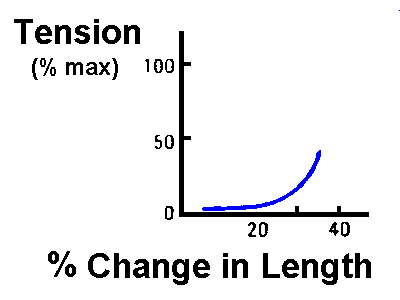 As resting muscle is stretched, the tension increases exponentially.
The resting tension is also affected by a variety of influences, including
time-dependent factors (stress relaxation), creep and myocardial
lusiotropy.
As resting muscle is stretched, the tension increases exponentially.
The resting tension is also affected by a variety of influences, including
time-dependent factors (stress relaxation), creep and myocardial
lusiotropy.
Active properties - isometric length versus tension
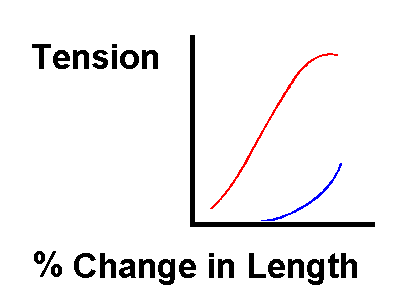
In examining the above curve, note that the curve reflects the sum of
the tension generated due to muscle contraction and the resting
tension. The basic idea is simple - as the resting length increases, so
does the tension generated, as noted above. This is the basis for Starling's
law of the heart: increasing venous return to the heart stretches the
ventricle, which in turn results in more forceful ejection of blood at the
very next heartbeat!
This brings us to a very important point: the isometric length-tension
curve helps us greatly when we examine isotonic shortening. If we examine
the length of the muscle after an isotonic contraction, and the
corresponding tension, we find this tension to be the same as the tension
we would have obtained had we performed an isometric contraction
at this final length!! In other words, the isometric curve provides a limit
for the isotonic performance of the muscle.
The effect of inotropy
Inotropy is the term applied to changes in heart muscle performance
independent of alterations in preload and afterload. This implies that
any one of the active function curves that we plot will alter once the
inotropic state of the myocardium changes. The curve commonly used to
assess inotropy is the isometric length-tension curve - a positive
inotropic stimulus shifts the curve up and to the left, and a negative
stimulus down and right.
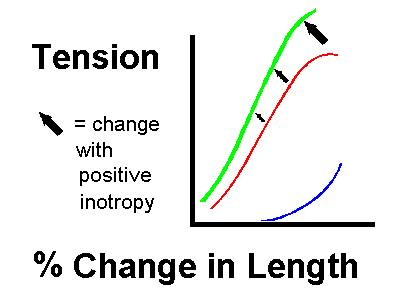
Inotropy varies with a variety of factors, including increases associated
with increased frequency of contraction and the effect of post-extrasystolic
potentiation, as well as catecholamines, glucagon, and inotropic drugs;
and decreases with myocardial ischaemia, heart failure, and depressant
agents (including almost all anaesthetics).
The Cardiac Cycle.
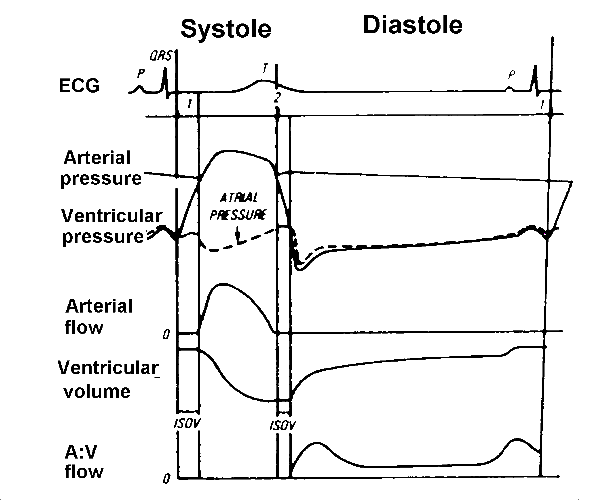
It is convenient to plot against time, various cardiac events on the same
set of axes (commonly termed "Wiggers' diagram"). We will not consider all
the events here, but concentrate on the relationship between pressure and
volume in the left ventricle. You can see that this forms a closed loop:
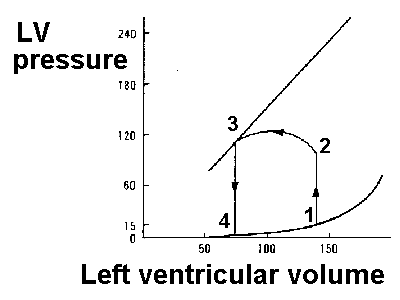
Work around the loop: passive filling of the ventricle occurs from point
"4" to point "1", there is an isovolumetric increase in pressure between
1 and 2, blood is ejected between 2 and 3, and then isovolumetric relaxation
occurs back down to point 4.
The utility of our simplistic curves for isolated muscle now becomes
apparent. Because passive filling occurs between 4 and 1, this curve
approximates that seen with passive stretch of cardiac muscle, the so-called
"passive pressure-volume curve". The slope of this curve (delta P/delta V)
represents the stiffness of the LV wall, more frequently expressed by the
compliance, which is the reciprocal (delta V/delta P).
Also note that if we were to completely obstruct left ventricular
outflow, then we would create a situation similar to our "isometric
length-tension curve". If we indeed do this, then we get an "isovolumetric
pressure-volume curve", with remarkably similar characteristics. There
is then an almost linear relationship between the ventricular end-diastolic
volume and the maximum pressure developed. And surprise, surprise, the
end systolic pressure-volume point on our left-ventricular pressure-volume
curve (point 3 in our diagram) falls on this curve . Just as with
the isolated muscle, the isovolumetric pressure-volume curve represents
a limiting curve for the pressure-volume loop!
Factors affecting ventricular performance
As indicated in West, there are four major players in determining
ventricular systolic performance:
- Preload - ideally expressed as the wall tension at the
end of diastole, we often cop out by using ventricular end-diastolic
volume (or, even worse, end-diastolic pressure). It is here
that we invoke Starling's law of the heart - "mechanical energy
set free on passage from the resting to the contracted state is
a function of the length of muscle fibre". Practically, as
preload increases, so does stroke volume. In order to thoroughly
confuse you, some physiologists maliciously term this "heterometric
autoregulation"! The mechanism is superb - within a heartbeat,
increased venous return to either ventricle is compensated for
by increased output. This also serves to balance input to the
two ventricles, preventing overloading of either the pulmonary
or systemic circulation.
- Afterload. This should be seen as the sum of all forces opposing
ventricular ejection. Determination of these forces is complex, so
we usually use systolic left ventricular pressure as a reasonable
measure of afterload. As afterload increases, so ejection of blood
slows and the volume ejected diminishes (for that beat). Note that
for the subsequent beat, because of the increased end-diastolic
volume, Starling's law will come into play. Then however, a peculiar
thing happens. Despite the increased afterload, and the consequent
increase in end-diastolic pressure (with normal stroke volume by
the Starling effect), there is over subsequent beats a gradual fall
in left-ventricular end-diastolic pressure, and stroke volume is
nevertheless maintained! This peculiar effect (variously known as
the "Anrep effect", or even more confusingly "homeometric
autoregulation") is of uncertain importance in the intact circulation.
- Inotropy, which as it increases, enhances both stroke volume
and velocity of ejection. In other words, the entire pressure
volume curve is shifted by changes in inotropy - we are not
surprised by this, as we know that the end-systolic pressure volume
point tracks the isovolumetric pressure volume curve, and we
can deduce that increased inotropy will shift the isovolumetric
pressure-volume curve up and to the left, in a similar fashion
to the changes wrought by inotropes on the isometric length-tension
curve.
- Heart rate. As heart rate increases, so does inotropy (the
"staircase" phenomenon), but this is tiny compared to the
overall increase in cardiac performance (output per minute) seen
with rate changes. Such substantial changes in output are however not seen when the rate changes are artificially induced
(for example, by cardiac pacing), because the major determinant
of cardiac output is the peripheral demand of the body, and not
some arbitrary myocardial parameter.
Ventricular relaxation
This is a complex topic. Quite apart from the overall passive filling
properties of the ventricle, the rate of relaxation of the ventricles
can have a marked effect on early ventricular filling. Ventricular
relaxation is influenced by:
- inotropic stimulation (faster)
- fast heart rates (faster)
- non-uniform heart activation (slowed)
- altered timing of afterload imposition
An integrated approach
The integration of cardiac performance and peripheral demand is
the topic of another lecture.
References
- West JB, ed. 1990, 12ed.
Best & Taylor's Physiological Basis of Medical Practice.
Williams & Wilkins, ISBN 0-683-08947-1.
The best cover of cardiac physiology that we have found
in a general physiology book! Worth a read.
- Guyton AC, Jones CE & Coleman TG. 1973, 2ed.
Circulatory Physiology:
Cardiac output and its regulation. WB Saunders.
ISBN 0-7216-4360-4
A superb book. If you have the time, read it from cover
to cover. At the very least, skim through it.
 As resting muscle is stretched, the tension increases exponentially.
The resting tension is also affected by a variety of influences, including
time-dependent factors (stress relaxation), creep and myocardial
lusiotropy.
As resting muscle is stretched, the tension increases exponentially.
The resting tension is also affected by a variety of influences, including
time-dependent factors (stress relaxation), creep and myocardial
lusiotropy.
 As resting muscle is stretched, the tension increases exponentially.
The resting tension is also affected by a variety of influences, including
time-dependent factors (stress relaxation), creep and myocardial
lusiotropy.
As resting muscle is stretched, the tension increases exponentially.
The resting tension is also affected by a variety of influences, including
time-dependent factors (stress relaxation), creep and myocardial
lusiotropy.



